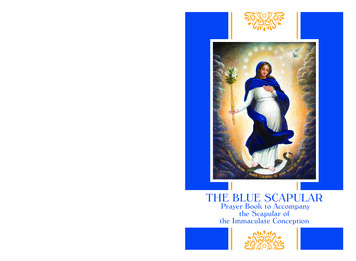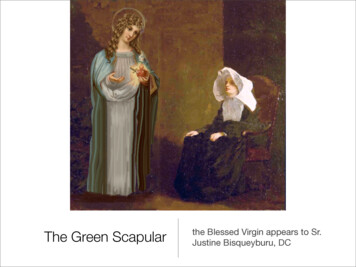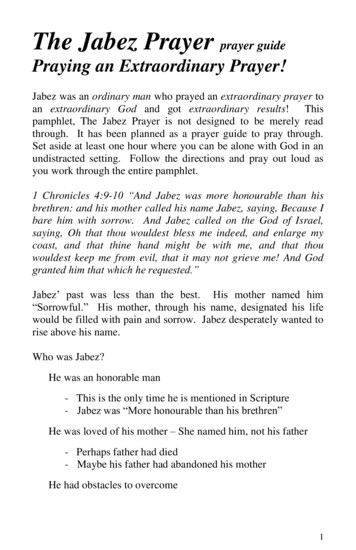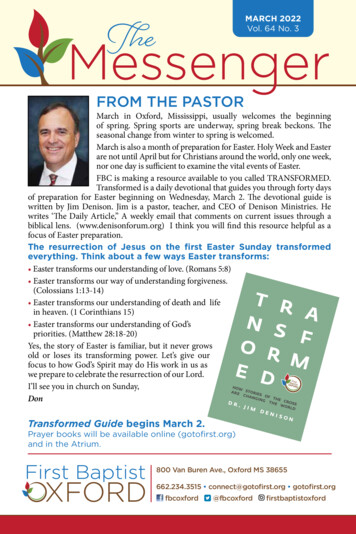
Transcription
THE BLUE SCAPULARTHE BLUE SCAPULARPrayer Book to Accompanythe Scapular ofthe Immaculate Conception
THE BLUE SCAPULARPrayer Book to Accompanythe Scapular ofthe Immaculate Conception
Blessed Virgin Mary Immaculately Conceived,commissioned by the Marian Fathers and painedby Francis Smuglewicz (1745-1807). In 1782, thispainting was placed in St. Vitus Church in Rome.
THE BLUE SCAPULARPrayer Book to Accompanythe Scapular ofthe Immaculate ConceptionEditorsJanusz Kumala, MICAndrew R. Mączyński, MICLicheń Stary 2021
Copyright 2021 Centrum Formacji Maryjnej“Salvatoris Mather,” Licheń Stary, 2021All world rights reserved.For texts from the English Edition of the Diary ofSt. Maria Faustina Kowalska “Divine Mercy in My Soul,”Copyright 1987 Congregation of MariansWritten and edited with the collaboration of:Michael B. Callea, MICAnthony Gramlich, MICS. Seraphim Michalenko, MICKonstanty OsińskiTranslated from Polish:Marina Batiuk, Ewa St. JeanProofreaders:David Came, Richard Drabik, MIC, Christine KruszynaPage design:Front cover: “Woman of the Apocalypse” – Most Blessed VirginMary, Immaculately Conceived. Painting by Janis Balabon, 2010.General House of the Marian Fathers in Rome, Italy.Imprimi potestVery Rev. Fr. Kazimierz Chwalek, MIC,Superior of the B.V.M., Mother of Mercy ProvinceDecember 8, 2017ISBN 978-1-59614-248-0Published through the efforts of the General Promoter ofthe Marian Fathers’ Confraternity ofthe Immaculate Conception of the Most B.V.M.Fourth amended edition
.was admitted tothe Confraternityof the Immaculate Conceptionof the Most Blessed Virgin Marywhich entitleshim/her to share spiritually in the life,prayers, and good works ofthe Congregation of Marian Fathers ofthe Immaculate Conception ofthe Most Blessed Virgin Maryand was vested inthe Blue Scapularwhich grants him/her participation inplenary indulgences and special gracesapproved by the Holy See.The name of the new member was inscribed inthe Confraternity Register.The ceremony of admissionand investiture took place at.and was performed byRev. .
The Immaculate Conceptionby Peter Paul Rubens (1577-1640),Museum Prado (Madrid, Spain).
Tableof contentsPreface .History of the Congregation of MarianFathers and of the Confraternity ofthe Immaculate Conception of theMost B.V.M .Brief History of the Congregationof Marian Fathers of the ImmaculateConception of the Most B.V.M .Timeline of Marian Fathers .History of the Confraternity of theImmaculate Conception .1113131617History of the Blue Scapular of theImmaculate Conception of the MostBlessed Virgin Mary .What is a scapular? .Types of scapulars .Blue Scapular .26262730Theology of the Blue Scapular .The Church’s approval .Biblical foundations .Mystical meaning .34343740
Spirituality of the of Contemplative Nuns ofthe Immaculate Conception .Special graces .Symbolism .Role of the scapular .Availing Oneself of Graces Associatedwith the Confraternity of theImmaculate Conception and Wearingthe Blue Scapular .Responsibilities of people accepting theBlue Scapular and becoming membersof the Confraternity of the ImmaculateConception .Nature of the Confraternity of theImmaculate Conception. Its goals andspiritual benefits .Indulgences attached to the Scapularof the Immaculate Conception and theMarian Fathers’ Confraternity .Prayers to Our Lady ImmaculatelyConceived .Daily offering of oneself to the BlessedMother .Chaplet of Ten Evangelical Virtues .Angelus .We Fly to Your Patronage .41424345474848535556565960
Hail, Holy Queen (Salve Regina) .Prayer of St. Bernard (Memorare) .Prayer to Mary according to St. Bernard ofClairvaux .Prayer to Mary Immaculate for a life ofholiness .Prayer for the Solemnity of the ImmaculateConception (by St. John Paul II) .Litany of Loreto .Litany of the Immaculate Conception .Litany of the Mysteries of Mary’s life .Litany to the Immaculate Heart of Mary(by Blessed John Newman) .Novena before the Solemnity of theImmaculate Conception .6060Prayers for the Deceased .Prayers for the Departed for every day ofthe week .Prayer for all the Deceased .Prayer for the Deceased (by Blessed JohnNewman) .Act of Heroic Love .Act of Mercy for Souls in Purgatory .Litany for the Souls in Purgatory .816162636568717273828485878788
Prayers for the Conversion of Sinnersand for Divine Mercy upon the World . 93Prayer for sinners . 93Act of Oblation for Sinners . 94Prayer to The Divine Mercy . 96Prayer for Divine Mercy . 97Prayer for a Merciful Heart . 98Act of Trust in The Divine Mercy . 98Litany of Praises of The Divine Mercy . 99The Chaplet of The Divine Mercy . 102Act of Entrusting the World to The DivineMercy (by St. John Paul II) . 103Admission to the Confraternity of theImmaculate Conception and Investiturewith the Blue Scapular .Order of Admission and Investiture .Introductory Rite .Reading .Intercessions .Prayer of Blessing .Admission to the Confraternity .Investiture with the Blue Scapular .Concluding Rite .Additional Explanations .104105105107109111112114116117Appendix . 121Bibliography . 159
PrefaceThe sign of the Blue Scapular tells us thatGod introduced us to the Marian road of life. Weare His children who joined the community ofthe Church through the gate of holy Baptism sothat we could make our pilgrimage to the gloryof heaven together with all our brothers andsisters in faith. On that pilgrimage, Mary, whoselife’s beauty inspires us to fulfill our calling toholiness, serves as our Mother and Guide.People who discover the beauty of livingtheir lives with Mary, and who wish to imitateher, accept the Scapular of the ImmaculateConception of the Most Blessed Virgin Mary inorder to become like Christ.The Blue Scapular is an external symbol forstudents from the school of spirituality of theImmaculate Conception, whose inspiration andmaster was St. Stanislaus Papczyński, Founderof the Congregation of Marian Fathers.The mystery of the Immaculate Conceptionteaches us that God is the Source of salvation.We find the sense of our lives in God’sdisinterested and gratuitous love. The radiance11
of the Woman Full of Grace inspires us to strivefor the beauty of our hearts so that they mayalways be the mystical temples of God, holy andwithout blemish.The very decision to accept the Blue Scapularis already a grace of God as well as being Hisinvitation to become even more formed in thefulfillment of our Christian vocation so that wemay live in friendship with God and people afterthe example of Mary, our Immaculate Mother.Our spiritual bond with Mary prompts us tobuild a fraternal community with people who alsoregard Mary as their Master of life. Therefore,may the membership in the Confraternity ofthe Immaculate Conception become for us anadditional incentive to love God and our neighboreven more faithfully.Fr. Janusz Kumala, MIC
History of the Congregation of MarianFathers of the Immaculate Conception of theMost B.V.M. and of the Confraternity of theImmaculate Conception ofthe Most B.V.M.Brief History of the Congregation ofMarian Fathers ofthe Immaculate Conceptionof the Most B.V.M.The Congregation of Marian Fathers wasfounded in 1670. It is the first native male religiousOrder established in Poland. Its founder was a Pole– Saint Stanislaus of Jesus and Mary Papczyński(1631-1701), who was born in Podegrodzie, nearStary Sącz, in southern Poland. The Order’s cradleis the Marian Forest, near Skierniewice in theMazovia district. In 1699, the Holy See approvedthe Order of Marian Fathers upon the Rule ofthe Ten Evangelical Virtues of the Blessed VirginMary. The holy Father Founder set three goalsto his new community: spreading devotion to the ImmaculateConception of the Blessed Virgin Mary,13
praying for the faithful departed (souls inPurgatory), especially victims of wars andepidemics, as well as those who were notprepared for death, working apostolically, especially among thespiritually neglected.The holy Fr. Stanislaus was also a zealousapostle of sobriety, which he made one of hisOrder’s principal characteristics. In its early years,the new community met with many difficulties.There were times when its very existence wasin question. However, the Order founded bySt. Stanislaus proved stronger than the manyobstacles it encountered over the centuries.Thanks to the Venerable Servant of God, Fr.Casimir of St. Joseph Wyszyński (1700-1755),one of the most faithful followers of the SaintFr. Founder, the Order strengthened and grewduring the 18th century. Under Fr. Casimir’sleadership, new monasteries were set up inLithuania, Belarus, and even as far away asPortugal. Through his efforts the Marian Ordergrew in numbers and became an internationalcommunity. Among its members there were Poles,Lithuanians, Czechs, Hungarians, Italians, theFrench, and the Portuguese. By the second half14
of the 18th century, the Marians had also foundeda monastery in Rome.This chain of dynamic growth was broken withthe political downfall of Poland, and subsequentpartitions of this nation’s territory at the end ofthe 18th and then in 19th centuries. In 1864, onthe strength of a decree issued by the Czaristauthorities, the Marian Order – along with otherCatholic Orders – was suppressed and began to dieout slowly. In 1909, on the eve of the community’stotal extinction, Fr. George Matulaitis-Matulewicz(1871-1927), a Lithuanian-born professor of theSpiritual Academy St. Petersburg (Russia), andlater the Bishop of Vilnius, joined the Mariansin secret from the Czarist authorities. He startedthe work of renewal and reform of the Order,bringing it back to life. In 1987, Pope St. JohnPaul II beatified him.Currently, the Marians number about 500priests and brothers working in 19 countriesaround the world, including missions in SouthAmerica, Africa, and Asia.15
Timeline of the Marian FathersDecember 11, 1670 – Fr. Stanislaus Papczyńskimade the Oblatio as an act of offering himselfin the service of God and Mary, as well asa public declaration of his intention to foundthe Congregation of Marian Fathers.October 24, 1673 – Bishop Stanislaus JacekŚwięcicki gave his approval for the Congregation’sfirst religious house.November 24, 1699 – Pope Innocent XII approvesthe Marians as an Order with solemn vows uponthe Rule of the Ten Evangelical Virtues of the MostBlessed Virgin Mary that obliged the Marians towear the Blue Scapular.1786 – Holy See approves revised MarianConstitutions, which expand apostolic worksto include parish schools and preachingthe missions.18th-19th centuries – Marian monasteries inRome, Portugal, Poland, and Lithuania weresuppressed due to the political upheaval.November 29, 1909 – In the presence of the lastliving Marian, Fr. Vincent Sękowski, Fr. GeorgeMatulaitis-Matulewicz made his vows and wasadmitted to the Marian Order.16
November 28, 1910 – Pope Pius X approved newConstitutions and the renewed form of Marian life.June 28, 1987 – Beatification of ArchbishopGeorge Matulaitis-Matulewicz, Renovator ofthe Congregation.September 16, 2007 – Beatification of FatherStanislaus of Jesus and Mary Papczyński,Founder of the Marians.June 5, 2016 – Canonization of BlessedStanislaus Papczyński in Rome.History of the Confraternityof the Immaculate ConceptionThe Confraternity of the ImmaculateConception has existed with the Congregationof Marian Fathers since the 18th century.Saint Stanislaus of Jesus and Mary Papczyński(1631-1701), the Founder of the Marian Fathers,considered spreading devotion to the ImmaculateConception of the Most B.V.M. as one of hisOrder’s principal goals. The holy Fr. Founderfervently encouraged his spiritual sons to establishConfraternities of the Immaculate Conception atthe Marian churches. This was already reflectedin the first laws of the Order, published in 16941698. The confraternities were meant to provide17
assistance to Poor Souls suffering in Purgatorybecause St. Stanislaus associated devotion to theImmaculate Conception with helping the faithfuldeparted. Excited by the idea of giving himself intoMary’s bondage, he wished not only to live freeof evil and sin, but to aid the purification fromthe stain of sin of all those who were sufferingin Purgatory.The last chapter of The Rule of the TenEvangelical Virtues of the B.V.M., upon whichthe Holy See approved the Marian Order in 1699,commanded the Marian religious to wear theScapular of the Immaculate Conception of theMost B.V.M. They wore it beneath their whitehabit. Committed by virtue of their calling tospread devotion to the Immaculate Conception ofthe Blessed Mother, they wished also to popularizethe scapular among the faithful.The Venerable Servant of God Fr. Casimir ofSt. Joseph Wyszyński (1700-1755) was the firstamong the Marians to approach the TheatineFathers in Rome with the request for permissionto bless the Blue Scapular and confer it upon thefaithful. The permission was granted in 1733 withthe obligation of its renewal every three years. TheServant of God resided then in Rome and held theoffice of Procurator General of the Marian Fathers.18
At that time, the Theatine Fathers were the onlyones with the authority, granted by the Holy See,to delegate other priests to invest the faithfulwith the Scapular of the Immaculate Conception.Father Wyszyński probably wished to make thewearing of the Blue Scapular and prescribedassociated practices one of the elements of pietyof the above-mentioned Confraternity. From thattime on, members of the “Scapular Confraternity”or our Confraternity (as the Marian Fathers beganto call the Confraternity of the ImmaculateConception of the B.V.M. later) were registeredin the Confraternity Book, and received the BlueScapular as a sign of belonging.The Marian monastery in Goźlin [Poland]still houses a leather-bound 18th-century book,which contains the names of people, admittedto the local Confraternity of the ImmaculateConception of the Most B.V.M. in 1777-1788.The Confraternity members, mostly the MarianFathers’ benefactors, among whom there werewell-known personalities, used to fulfill variousservices at the local church during “holy days.”As the Confraternity Statute stated, their “firstand principal duty, bound by a special promise,is to revere, promote, and defend the honor ofthe Immaculate Conception of the Most Blessed19
Virgin Mary. As an external sign [of that] they areto wear a white-color scapular embellished withblue. This scapular is a sign, as well as a token,of the Most Holy Virgin Mary’s protection.”Another Register of the Confraternity of theImmaculate Conception, similar to the one fromGoźlin, comes from the Marian monastery onMount Balsamão in Portugal; it dates back to1774. Today this book is kept in the GeneralArchives of the Congregation of Marian Fathersin Rome. Its greatly yellowed pages preserveseveral hundred first and last names of peopleupon whom the Marian Fathers conferred theBlue Scapular.For the first time, the Marian historicaldocuments mention the establishment ofa Confraternity of the Immaculate Conceptionon June 26, 1734. The entry speaks of an officialformation of this confraternity at the Marianchurch in Puszcza Korabiewska [now PuszczaMariańska or the Marian Forest – location of theCongregation’s first monastery].The Theatine Fathers repeatedly renewed theprivilege granted to the Marian Fathers, which wasfirst obtained by Fr. Wyszyński. On August 30,1751, through the efforts of the Venerable Servantof God Fr. Casimir, the Theatines again granted20
the right to invest with the Blue Scapular—thistime to the Superior General and to six otherMarian Fathers in Poland. On May 5, 1753, beforeleaving for Portugal, the Venerable Servant of Godobtained once more from the Superior Generalof the Theatines the privilege of spreading theScapular of the Immaculate Conception, this timein the Kingdom of Portugal. More than 20 yearslater, the continuator of Fr. Wyszyński’s activityin Portugal, Fr. Alexis Fischer, approached bymeans of a letter the Theatine Fathers in Romewith the request for a renewal of the same privilegeof investiture granted in 1753. His letter is datedJanuary 26, 1776.Political upheavals of the first half of the 19thcentury were undoubtedly the reason for thedifficulties in communication with the Theatinesin Rome regarding the further spreading of theScapular by the Marian Fathers in Poland. Thus,it becomes understandable why on February 20,1841, Fr. Jan Dziewulski petitioned the HolySee directly and asked for permission for theMarian Fathers to continue spreading the BlueScapular. In the 19th century, three zealousMarian priests, noted for their intellectual andspiritual formation: Fathers Stanislaw Porzycki,Jerzy Naruszewicz, and Alexander Wilczyński,21
distinguished themselves particularly in promoting“our Confraternity” established at the churchesserved by the Order. Let the statistics on thedeanery in Marijampole, Lithuania for the year1888, testify to the fruits brought about by thepastoral activity of these Fathers and otherMarians who followed their example. The MarianFathers had then three monasteries in Lithuania:Marijampole, Miroslavas, and Iglaukai. Theyalso conducted pastoral ministry in neighboringchurches. There were 99 active confraternitiesat the 15 churches of that deanery. Along withseveral other confraternities, each church alsohad the Confraternity of the Scapular of theImmaculate Conception of the Most BlessedVirgin Mary.The confraternities existing at the Marianchurches exerted a considerable influenceover the religious life and Marian devotionboth in their parishes and in the vicinity. Theycontributed to the moral renewal and encouragedcharitable works. They were instrumental in thesanctification of their members by promotingfrequent confession and participation in HolyMass on the feast days of Our Lady.The Renovator and Reformer of the MarianOrder, Blessed Archbishop George Matulaitis22
Matulewicz, also asked the Theatines in Romefor authorization to invest the faithful with theBlue Scapular. The permission was granted himon December 1, 1911.On June 3, 1992, Fr. Donald Petraitis, MIC,then the Superior General of the Marians,obtained from the Superior General of the TheatineOrder a perpetual permission for himself and hissuccessors to bless and confer the Scapular ofthe Immaculate Conception of the Most BlessedVirgin Mary. This permission was reaffirmedon March 19, 2005, by a special letter of theTheatine Fathers’ General Superior addressed tothe Superior General of the Marians and to theGeneral Promoter of the Association of MarianHelpers. By another letter of July 16, 2008,the Superior General of the Theatines gave theMarian Fathers’ Superior General a perpetualpermission to sub-delegate priests, both Marianand non-Marian, to bless and confer the BlueScapular, according to canon 1169 of the Codeof Canon Law.*Thus, according to their centuries-longtradition, the Marian Fathers promote among thefaithful the Blue Scapular, which is the external*View the official permission given by the Theatine Fathers tothe Marian Fathers, Appendix, Statutes, p. 13.23
mark of the Confraternity members’ piety anddevotion to the Immaculate Conception of theB.V.M., fostered by the Congregation of MarianFathers almost from the beginning of its history.Confraternities of the Immaculate Conceptionrepresent one of the important means by whichthe Congregation of Marian Fathers spreadsdevotion to the Immaculate Conception of theMother of God and assists the souls suffering inPurgatory, of whom the Immaculate Mother ofChrist is a particular advocate.The Marian Fathers in the United Statesstarted spreading the Scapular of the ImmaculateConception in the 1960s. This action metwith a remarkable response, and it was laterextended to the United Kingdom, Poland, Brazil,and Ukraine. Today the Confraternity of theImmaculate Conception of the B.V.M. at theCongregation of Marian Fathers counts severalthousand members.24
This image of Mary Immaculate is from the title pageof the Portuguese edition of “Information about theGarment or Scapular of the Immaculate Conception,”published by the Marians in 1758.
History of the Blue Scapular ofthe Immaculate Conception ofthe Most Blessed Virgin MaryWhat Is a Scapular?The scapular (the word comes from the Latinscapula—meaning an arm, shoulders, and back)is a sleeveless garment consisting of two wide,rectangular pieces of material, slipped overa religious’ head onto the habit. It is a part of thereligious garb of some Orders like the Benedictinesor the Dominicans. Sometimes a hood, knownin the East as the analobo, is attached to thescapular. This type of garb was introduced inthe 5th century by St. Benedict as a scapolarepropter opera—that is, an apron worn to protectthe habit during physical labor.Over time this scapolare underwent somechanges. It gradually became longer, and thematerial from which it was made changed aswell. It was no longer a protective garment buta symbol, a sign of dedication to God. Spiritualwriters spoke of it as iugum Christi—the yokeof Christ. In the 12th century, the Rules of theServites, Benedictines in certain abbeys, and26
Carmelites required that the monks wear theirscapulars even in their sleep as a source ofspiritual protection through the night.In the Middle Ages, when many laypeoplewished to participate in some way in the spirituallife of the religious orders, various religiousassociations like “Third Orders,” “Confraternities,”and “Oblates” were established. The sign ofacceptance into the spiritual community wasthe vesting of the scapular to identify its membersas belonging to each distinctive religious order.Types of ScapularsThere are various types of scapulars dependingon the religious Order with which they areassociated. The origin of most of them is linkedto an apparition of the Blessed Mother instructinga particular religious order to promote a certaintype of scapular. The oldest among them is the“white” scapular of the Holy Trinity that datesback to 1200. The “brown” Carmelite scapularoriginated in 1251, while the “black” scapular ofthe Servites of the Blessed Mother of Sorrows—in 1255.The majority of the scapulars had a singularaffinity with the Mother of God, not only because27
they were connected with a particular Marianapparition, which then began the tradition ofa particular scapular, but also because of thedevotion associated with the practice of wearinga scapular and the indulgences attached to it.The most revered, known, and popular among theMarian scapulars is the Carmelite one. Its origin isshrouded in legend. According to the tradition, theVirgin Mary personally gave this scapular in 1251to the venerable and particularly devout SuperiorGeneral of the Carmelites, Blessed Simon Stock.The Blessed Mother is believed to have promisedthat whoever wore the Carmelite scapular wouldnot suffer the fires of hell.At first, people used to place the scapularover their clothes or armor, and it was worn withparticular pride on solemn occasions. But overtime the visible, showy piety became more discreet,and the scapular “moved” under people’s clothing.Consequently, it had to become smaller in size, butit continued to look the same: two pieces of clothjoined by ribbons, which one would put on overone’s head. Sometimes the material was decoratedwith an embroidered or painted picture. Now thescapular was hidden from the onlookers’ eyes andwhen it happened to be exposed or revealed—likein the famous Polish painting by Jan Matejko28
showing the prostrate figure of a nobleman withthe scapular visible on his bare chest—peopleperceived it as a powerful witness.The scapular was always vested by authorizedpersons and always according to a strictly definedceremony that concluded with a special blessing.The acceptance of the scapular meant, in eachcase, the assumption of specific responsibilitieswhich, in their essence, usually referred to therule of life of a particular religious community.The Church has always looked favorably uponscapulars, endowing them with indulgences,defining their prerogatives, establishingconditions of investiture, and even designatingtheir shape, size, and the manner of wearingthem. On December 6, 1910, by the decree ofthe Congregation of the Holy Office, Pope Pius Xpermitted the substitution of every scapular witha medal bearing on the obverse the image of theSacred Heart of Jesus and on the reverse—theimage of Our Lady. The regulations regarding itsconferral in this new form, and the indulgencesand blessings attached to it, remained unchanged.Undoubtedly, the idea of allowing the laity’sparticipation in the spiritual life of religious orders,expressed in the act of receiving a “new vestment”—even if this vestment was only a symbolic one29
(the scapular was also dubbed “a miniature habit”)has at all times been something positive andprecious in the eyes of the Church.Blue ScapularThe Blue Scapular originated in Italy, and itis connected with the person of the VenerableServant of God Ursula Benincasa (1547-1618),who founded the Congregation of the Oblates ofthe Immaculate Conception of the Most BlessedVirgin Mary in the year 1583. She also foundedthe Hermitage of the Contemplative Nuns ofthe Immaculate Conception. The rule of bothcommunities was approved by Pope Gregory XVon April 7, 1623.In 1617, in Naples, Italy, on the Feast of thePresentation of the Lord, Ursula, having receivedHoly Communion, had a vision of the BlessedMother clothed in a white garment over whichshe wore another garment of azure blue. In herarms, Mary held the Infant Jesus. Our Lady wassurrounded by many persons, all similarly attired.The Blessed Mother spoke to Ursula in thesewords: “Cease weeping, Ursula, and turn yoursighs into heartfelt joy. Listen closely to whatJesus, whom I am holding in my lap, will sayto you.”30
Then Jesus revealed to Ursula that she wouldfound a convent where 33 nuns, dressed in thesame attire as the Most Blessed Virgin Mary of hervision, would live a life of solitude and seclusion.The Savior promised special graces and manyspiritual gifts to those who would zealously followthis way of life.The Venerable Servant of God besought theLord to extend these favors also to such peoplewho, living in the world, would have a specialdevotion to the mystery of the ImmaculateConception, observe chastity according to theirstation in life, and wear a small blue scapular.As a sign that her prayer was heard, Jesusshowed Ursula in a vision a multitude of angelsdistributing scapulars all over the earth. Thisscene is artistically captured in a fresco at theTheatine Sisters’ Convent in Naples.Overwhelmed with joy, Ursula personally madescapulars similar to the ones she saw in hervision, had them blessed, and distributed themamong the faithful. The practice of wearing theBlue Scapular began to spread quickly alreadyduring Ursula’s lifetime. After her death, herspiritual daughters undertook the promotion ofthis scapular as their Order’s special mission. OnAugust 7, 1793, Pope Pius VI recognized Ursula’s31
heroic virtues and proclaimed her a VenerableServant of God.In 1633, the Theatine Fathers in their GeneralChapter, recognized the Oblates of the ImmaculateConception and the community of contemplativenuns whose inception was rooted in the visionof Venerable Ursula as branches of their Order.From that time on, these two communities tookon the title of Theatine Nuns of the ImmaculateConception of the B.V.M. Thereupon, the TheatineFathers also began to promote devotion of theScapular of the Immaculate Conception, a taskassigned to them officially by Pope Clement Xon January 30, 1671. At the Theatine Fathers’request, he granted privileges and indulgencesto the B
Prayer Book to Accompany the Scapular of the Immaculate Conception . Blessed Virgin Mary Immaculately Conceived, commissioned by the Marian Fathers and pained by Francis Smuglewicz (1745-1807). In 1782, this painting was placed in St. Vitus Church in Rome.










